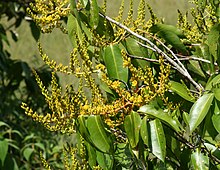
Buxus is a genus of about 70 species in the family Buxaceae. Common names include box or boxwood.

Dasiphora fruticosa is a species of hardy deciduous flowering shrub in the family Rosaceae, native to the cool temperate and subarctic regions of the northern hemisphere, often growing at high altitudes in mountains. Dasiphora fruticosa is a disputed name, and the plant is still widely referenced in the horticultural literature under its synonym Potentilla fruticosa. Common names include shrubby cinquefoil, golden hardhack, bush cinquefoil, shrubby five-finger, and widdy.
The taxonomy of the Pachypodium genus is the study of the species and subspecies in the genus Pachypodium. There are currently 25 recognized species in the genus, of which 17 are shrubs and eight are trees.
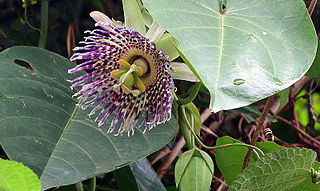
Passiflora ligularis, commonly known as the sweet granadilla or grenadia, is a plant species in the genus Passiflora. It is known as granadilla in Bolivia, Colombia, Nicaragua, Costa Rica, Ecuador, Mexico, the Azores Islands, South Africa and Peru; granadilla común in Guatemala; granadilla de China or parcha dulce in Venezuela and granaditta in Jamaica.

The yellow-faced grassquit is a passerine bird in the tanager family Thraupidae and is the only member of the genus Tiaris. It is native to the Central America, South America, and the Caribbean.

Hakea archaeoides is a large shrub or small tree commonly known as Big Nellie hakea and is endemic to forest areas on the north coast of New South Wales, Australia. It has clusters of red and greenish yellow flowers in the flowering season.
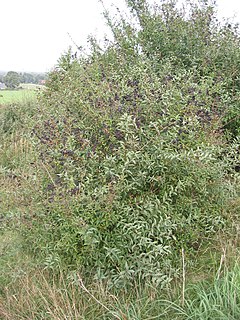
Ligustrum vulgare is a species of Ligustrum native to central and southern Europe, north Africa and southwestern Asia, from Ireland and southwestern Sweden south to Morocco, and east to Poland and northwestern Iran.

Mimetes chrysanthus is an evergreen, upright shrub of 1½–2 m high that has been assigned to the family Proteaceae. It has green, slightly stalked oval leaves of 3–4½ cm (1.2–1.8 in) long and 1–1¾ cm (0.4–0.7 in) wide. The inflorescences are near the tip of the branches, cylinder-shaped and consist of 50–70 densely cropped flower heads, each in the axil of a green leaf, consisting of 25–35 golden yellow, faintly sweet scented flowers. It is endemic to the Fynbos ecoregion of South Africa and is found in two locations, in the Western Cape province. The flowering season is from March to May or June, but flower heads sometimes occur in any other part of the year.
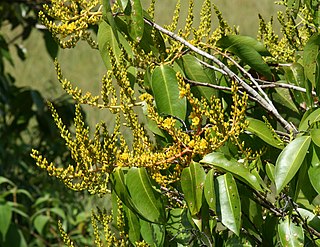
Ouratea is a genus of flowering plants in the family (Ochnaceae).

Schaefferia frutescens, the Florida-boxwood, is a species of flowering plant in the family Celastraceae,that is native to tropical regions of the Americas, from southern Florida in the United States, south through the Caribbean to Central America and northwestern South America, and also Veracruz in Mexico. It grows at close to sea level in Florida, and up to 600 m altitude in Puerto Rico.

Hakea chordophylla, commonly known as bootlace oak, bootlace tree, corkwood, or bull oak, is a species of shrub or small tree in the family Proteaceae found in central and northern Australia. Bares very showy golden yellow, pale green or cream nectar rich flowers in winter.

Persoonia chamaepitys, commonly known as the prostrate- or mountain geebung, is a shrub endemic to New South Wales in eastern Australia. It has a prostrate habit, reaching only 20 cm (7.9 in) high but spreading up to 2 m (6.6 ft) across, with bright green spine-like leaves and small yellow flowers appearing in summer and autumn.

Grevillea sessilis is a shrub which is endemic to Queensland in Australia.

Trema micrantha, the Jamaican nettletree or capulin, is a plant species native to warmer parts of the Western Hemisphere. It has been reported from Mexico, Central America, Bolivia, Argentina, Colombia, Ecuador, French Guiana, the Virgin Islands, Guyana, Venezuela, Suriname, Peru, Paraguay, Jamaica, Cuba, Hispaniola, Puerto Rico, and southern Florida. In Florida, it has been collected in 10 of the state's southern counties.

Hakea trineura is a shrub of the family Proteaceae and is endemic to Queensland Australia. It has large pendulous greenish-yellow flowers from May to September.

Hakea cinerea, commonly known as ashy or grey hakea, is a shrub in the family Proteaceae native to areas along the south coast in the Goldfields-Esperance region of Western Australia. It is a showy ornamental species bearing creamy-white flowers aging to orange with contrasting ash coloured grey-green leaves.

Hakea newbeyana is a shrub in the family Proteaceae and is endemic to an area in the southern Wheatbelt and Goldfields-Esperance regions of Western Australia. It is a prickly shrub with smooth grey bark and sweetly scented cream-yellow flowers in profusion in spring.
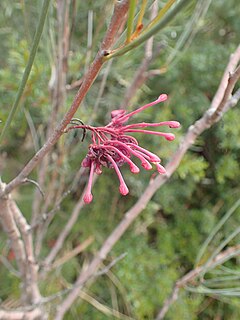
Hakea strumosa is a shrub in the family Proteacea endemic to an area in the Wheatbelt, Great Southern and the Goldfields-Esperance regions of Western Australia. A dense, very prickly shrub with a profusion of small, deep pink or red flowers in spring.

Hypericum phellos is a species of shrub or small tree in Hypericumsect. Brathys. The species is found in Colombia and Venezuela on scrubby slopes and moist woods.

Mimetes saxatilis or limestone pagoda is an evergreen, upright, rarely branching shrub of 1–2¼ m high, assigned to the family Proteaceae. The approximately oval leaves are 3½–5 cm (1.4–2.0 in) long and 1½–3 cm (0.6–1.2 in) wide with a blunt, thickened, reddish tip or with three crowded teeth. It has cylinder-shaped inflorescences topped by a crest of green leaves, further consisting of heads with 12-22 individual bright yellow flowers, each in the axil of a flat, green leaf. It is an endemic species that is restricted to limestone outcrops in the Agulhas plains in the very south of the Western Cape province of South Africa. It is considered an endangered species. Flowering may occur between July and December, but is unreliable in its timing, dependent on sufficient moisture availability.
